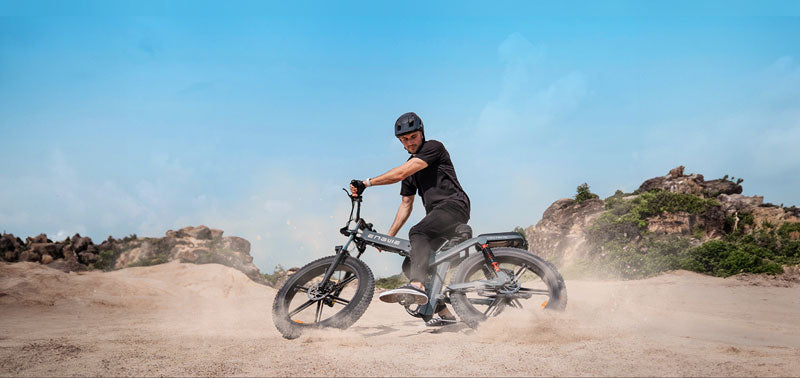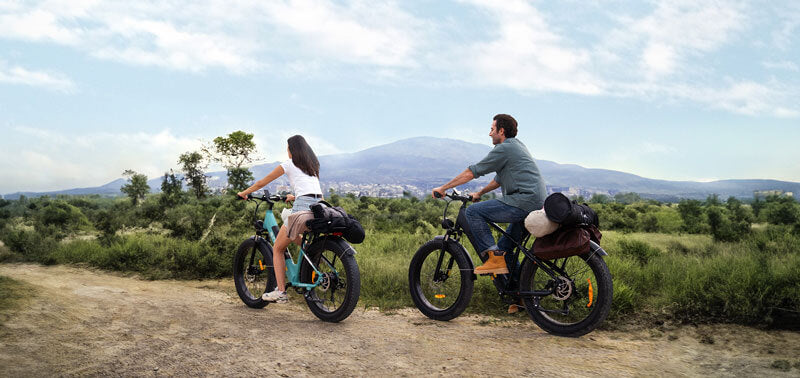A fat tire electric bike is a type of electric bicycle equipped with wider-than-normal tires, typically measuring 3.5 inches or more in width. These bikes are designed to handle a variety of terrains, including sand, snow, mud, and rough trails.
Fat tire electric bikes are popular for their versatility and ability to handle diverse environments. They are often chosen by riders who enjoy off-road cycling, beach riding, or those looking for a comfortable and stable ride in various conditions. These bikes come in different styles, from mountain bike designs to cruiser-style frames, catering to different preferences and riding styles. Additionally, electric fat tire bikes may have features like suspension systems, multiple gears, and various levels of electric assistance to enhance the riding experience.
Tips: Click here to view the fat tire electric bikes of Engwe.
How Fat Tires on Electric Bikes Work?
Fat tires on electric bikes work by providing several advantages over standard-sized tires, particularly in terms of stability, traction, and versatility. Here's how fat tires on electric bikes work:
1. Increased Surface Area
Fat tires are wider than traditional bike tires, typically measuring 3.5 inches or more in width. The increased surface area of the tire makes contact with the ground, providing better stability.
2. Enhanced Traction
The wider tires create a larger contact patch with the ground, improving traction. This is especially beneficial when riding on uneven, slippery, or loose surfaces such as sand, snow, mud, or gravel.
3. Improved Floatation
Fat tires excel in soft terrains like sand and snow because they distribute the bike's weight over a larger area. This prevents the tires from sinking into the surface, providing better floatation and making it easier to ride in such conditions.
4. Shock Absorption
The wider profile of fat tires acts as a natural shock absorber, helping to absorb bumps and vibrations. This can result in a more comfortable ride, especially on rough or uneven surfaces.
5. Versatility Across Terrains
Electric bike with fat tires are designed to handle a variety of terrains, making them versatile for off-road adventures. Whether it's rocky trails, snowy paths, or sandy beaches, the wide tires provide stability and control.
6. All-Season Riding
The design of fat tires makes them suitable for year-round riding. They perform well in winter conditions where traditional bike tires might struggle due to snow and ice.
7. Lower Tire Pressure
Electric bike fat tires are typically run at lower tire pressures compared to standard tires. This lower pressure contributes to the tire's ability to deform and conform to the terrain, enhancing traction and comfort.

What are the advantages and disadvantages of a electric bike with fat tires?
Advantages of Electric Bikes with Fat Tires
1. Versatility: Fat tire electric bikes are highly versatile and can handle a variety of terrains, including sand, snow, mud, and rough trails. This makes them suitable for off-road adventures and diverse riding conditions.
2. Stability and Traction: The wide tires provide increased stability and traction, enhancing the e-bike's performance on challenging surfaces. This is particularly beneficial when riding on uneven or slippery terrain.
3. Comfort: The wider tires can act as natural shock absorbers, providing a more comfortable ride by absorbing bumps and vibrations. This is advantageous, especially when riding on rough or uneven surfaces.
4. Suitable for Adverse Weather Conditions: Electric fat bikes are less likely to tip over and offer more stability in adverse weather conditions, making them a better choice for riding in adverse weather conditions.
5. Long Rides: Because of their wider tires, fat e-bikes offer more traction, making it easier to negotiate obstacles or travel longer distances, which are ideal for off-road touring and racing.
Disadvantages of Electric Bikes with Fat Tires
1. Weight: Fat tire electric bikes can be heavier than traditional bikes due to the larger tires and additional components, which can affect the bike's overall maneuverability and handling.
2. Rolling Resistance: The wider tires can result in increased rolling resistance on smooth surfaces, which may require more effort to pedal compared to bikes with narrower tires. This can impact overall efficiency and battery life.
3. Size and Bulk: The wide tires contribute to the overall bulkiness of the bike, which might make it less convenient for storage and transportation compared to bikes with standard tire sizes.
4. Cost: Fat tire electric bikes can be more expensive than traditional electric bikes, primarily due to the specialized components and design required for the fat tire feature.
5. Limited Speed: In some cases, fat tire electric bikes may not reach the same speeds as traditional electric bikes due to the added resistance from the wider tires.

How Much Do Fat Tire Electric Bikes Cost?
The cost of fat tire electric bikes can vary widely based on several factors, including brand, specifications, features, and build quality. Here are general price ranges for electric fat tire bikes:
- Entry-level Fat Tire Electric Bikes: $800 to $1,500
- Mid-range Fat Tire Electric Bikes: $1,500 to $3,000
- High-end or Premium Fat Tire Electric Bikes: $3,000 and above
The specific price within these ranges depends on various factors such as:
Motor Power: Bikes with more powerful motors or higher torque may be at the higher end of the price range.
Battery Capacity: Electric bikes with larger battery capacities often cost more and generally offer longer riding ranges.
Build Materials: The materials used in the frame and components (aluminum, carbon, steel, etc.) can affect the cost - lightweight and durable materials may increase the price.
Brand Reputation: Established brands or those known for high-quality electric bikes may have higher price tags.
Additional Features: Bikes with advanced features like full suspension, multiple gears, hydraulic disc brakes, and smart technology can be more expensive.
Fat Tire Electric Bikes Recommended
1. Engwe X26
Engwe X26 is a foldable electric bike with 26*4.0-inch fat tires. In addition to fat tires, this e-bike has a triple shock absorbance system, which combined allows the rider to ride smoothly and effortlessly on various terrains. Not only that, this fat tire electric bike also has a 1000W high-speed brushless motor, and a maximum speed of 31MPH, which can provide a good long-distance riding experience.
2. Engwe M20
Want a cool electric fat bike? Then Engwe M20 is a good choice. This e-bike looks like a motorcycle, with tire size of 20*4.0 inches, which is slightly smaller than the Engwe X26, but it still allows the rider to ride smoothly on a variety of terrains. In addition, Engwe M20 also has a dual shock absorbance system and 750W motor to ensure easy and stable riding.
3. Engwe E26
Available in high-step and step-thru frames, the Engwe E26 is an electric bike suitable for short-distance commuting. Its 26*4.0-inch tires can make the ride smoother, the 750W brushless motor can make the ride more effortless, and the 48V 16Ah lithium battery can make the ride longer. With the powerful fat tire electric bike, your daily commute will be easier and more enjoyable.

The Bottom Line
Fat tire electric bikes have many advantages and can adapt to a variety of terrains, making them ideal for outdoor sports and commuting. But when choosing an electric fat tire bike, consider your intended use, terrain, and personal preferences to find the type that best suits your needs.
You may also want to read:
Top 8 Fastest Electric Bikes 2024 (20 MPH & 28 MPH)
The Best Cheap Electric Bikes of 2024
A Buying Guide to Folding Electric Bike (Must Know Tips)